

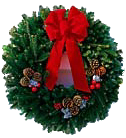
Christmas Store
The holidays are just around the corner so now is the time to fetch the finest gifts for the Labrador Lover on your Christmas list. We have over 100 gifts $50.00 and under. Visit our Christmas Store.
For the Lab
Bedding
Coats
Collars and Leads
Dog Bowls
Feeding Stations
Spa and Grooming
Toys and Treats
Travel and Accessories
For the Lab Lover
Apparel
Cards and Giftwrap
Fine Accessories
Gifts and All Occasions
Jewelry
Kids Only
For the Lab Home
Artwork
Books
Garden and Outdoor
Home Furnishings
Kitchen Accessories
Pillows, Throws, and Rugs
Gift ServicesGift Boxes
Gift Certificates
Recovering New Orleans
By Regan Michelle White
 Although named for the mythical Irish warrior Finn who protected Ireland during the 4th and 5th centuries, handler Kathleen Connor jokes that “my Finn is more of a momma’s boy than a fearless warrior.” Connor implied that the appellation was perhaps more apt since Finn also means “fair-haired” and he is a yellow Lab. Despite his momma’s boy personality, the name may suit him better than his handler gives credit. Finn is a certified Search and Rescue dog. He does wilderness, water, cadaver, and recovery searches.
Although named for the mythical Irish warrior Finn who protected Ireland during the 4th and 5th centuries, handler Kathleen Connor jokes that “my Finn is more of a momma’s boy than a fearless warrior.” Connor implied that the appellation was perhaps more apt since Finn also means “fair-haired” and he is a yellow Lab. Despite his momma’s boy personality, the name may suit him better than his handler gives credit. Finn is a certified Search and Rescue dog. He does wilderness, water, cadaver, and recovery searches.
 In order to get certified, the team was required to complete a 40-acre day evaluation, a 40-acre night evaluation and a 160-acre day evaluation that tests the dog’s ability to continue searching efficiently for extended periods. “It also tests the handlers ability to implement a search strategy effectively, knowing at all times via map and compass where the team is in the search sector and to monitor their dog,” Connor said. “We are not allowed to miss any subjects that are located in that search sector and we only have six hours to do so.”
In order to get certified, the team was required to complete a 40-acre day evaluation, a 40-acre night evaluation and a 160-acre day evaluation that tests the dog’s ability to continue searching efficiently for extended periods. “It also tests the handlers ability to implement a search strategy effectively, knowing at all times via map and compass where the team is in the search sector and to monitor their dog,” Connor said. “We are not allowed to miss any subjects that are located in that search sector and we only have six hours to do so.”
Due to the very nature of search and rescue work, the frequency of Connor and Finn’s deployment from their home near Harrisonburg, VA is sporadic. Some months they are called out every week and other times they can witness a three-month spell without a single call. Connor estimates that she and Finn average around 20 callouts a year. Typical searches the pair are called out for include drownings, house fires, lost hikers, lost children, Alzheimer’s patients, lost hunters, suicides and the hijinks of young men with too much to drink.
The dog team must be recertified every two years, thus training, training and more training is paramount to an effective team. Many times this training requires travel to other states. Finn has trained from Michigan to Mississippi, from Utah to Pennsylvania. Connor tries to attend at least one seminar a year. This past year, she attended one that worked on ‘Cadaster’ dog training, or training a cadaver dog in a disaster situation. “As luck would have it, I completed the seminar about two weeks before I was deployed to New Orleans,” she said. “They called it cadaster, but there is no training in the world that could prepare a dog team for what it was like in New Orleans.”
 A team of two dog handlers – including Connor – and four support staff left for New Orleans on November 13 and returned November 21. It took the team 18 hours over the course of two days to drive there. “It was not really a search and rescue mission, it was described as a recovery mission,” Connor said. “We were in the 9th Ward, right next to the levee that broke. We searched about a thirty block area.” Every morning the team would arrive at the staging area located at a former elementary school. The team would then receive their assignment for the day, round up the fire and police force members that were to accompany them for the day and then head out to the assigned sector. “We needed the police for protection,” Connor said. “We were more at risk from the feral dogs than people. Although, by the time we left more and more people were entering the area illegally, some to loot – for what, I don’t know, because there was nothing left – and others to gawk.”
A team of two dog handlers – including Connor – and four support staff left for New Orleans on November 13 and returned November 21. It took the team 18 hours over the course of two days to drive there. “It was not really a search and rescue mission, it was described as a recovery mission,” Connor said. “We were in the 9th Ward, right next to the levee that broke. We searched about a thirty block area.” Every morning the team would arrive at the staging area located at a former elementary school. The team would then receive their assignment for the day, round up the fire and police force members that were to accompany them for the day and then head out to the assigned sector. “We needed the police for protection,” Connor said. “We were more at risk from the feral dogs than people. Although, by the time we left more and more people were entering the area illegally, some to loot – for what, I don’t know, because there was nothing left – and others to gawk.”
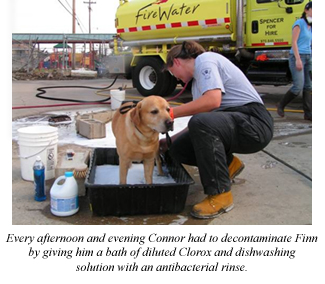 Members of the fire department came along to aid in breaking down doors and moving heavy obstacles. Connor and her team would quit for lunch around noon when they would head back to base to decontaminate by washing the dogs in a diluted solution of Clorox and Dawn dishwashing detergent and then rinsing them with a diluted chlorhexidine (antibacterial) solution. “In the afternoon we’d head out for another couple of hours of searching, come back, go through decon (decontamination) and head back to the hotel,” Connor said. “After dinner, the group would get together to discuss what happened that day and what we could do the next day to improve. Then (we’d) collapse into bed.”
Members of the fire department came along to aid in breaking down doors and moving heavy obstacles. Connor and her team would quit for lunch around noon when they would head back to base to decontaminate by washing the dogs in a diluted solution of Clorox and Dawn dishwashing detergent and then rinsing them with a diluted chlorhexidine (antibacterial) solution. “In the afternoon we’d head out for another couple of hours of searching, come back, go through decon (decontamination) and head back to the hotel,” Connor said. “After dinner, the group would get together to discuss what happened that day and what we could do the next day to improve. Then (we’d) collapse into bed.”
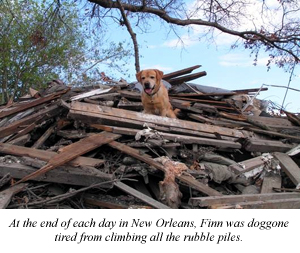 In terms of the task at hand, Connor explained that it wasn’t the work itself but the magnitude of its scale that was stupefying. “The actual work was not bad, just overwhelming,” she said. Connor described how during their first morning in the 9th Ward, everyone went for a tour of the area to be able to familiarize themselves with the devastation and the magnitude of what had occurred. “It took us several hours until we could get our minds wrapped around the situation and actually work,” she said. “I was petrified that Finn was going to hurt himself and was almost afraid to let him work. But when I let him out of the van he attacked every situation, every rubble pile, every destroyed home with complete confidence. I knew that I was going to be the weak link in the team and that if I didn’t get myself together I would take us out of the equation quickly. I gained my confidence from Finn. He never blinked or shirked at anything I asked him to do, whether it be a destroyed home where I couldn’t see a darn thing in the rooms he went through or climbing to the top of a 30-foot rubble pile chasing a scent.” When asked to attempt to compare it to other situations she and Finn have braved together, Connor’s reply was swift and decisive, “There is no comparison.”
In terms of the task at hand, Connor explained that it wasn’t the work itself but the magnitude of its scale that was stupefying. “The actual work was not bad, just overwhelming,” she said. Connor described how during their first morning in the 9th Ward, everyone went for a tour of the area to be able to familiarize themselves with the devastation and the magnitude of what had occurred. “It took us several hours until we could get our minds wrapped around the situation and actually work,” she said. “I was petrified that Finn was going to hurt himself and was almost afraid to let him work. But when I let him out of the van he attacked every situation, every rubble pile, every destroyed home with complete confidence. I knew that I was going to be the weak link in the team and that if I didn’t get myself together I would take us out of the equation quickly. I gained my confidence from Finn. He never blinked or shirked at anything I asked him to do, whether it be a destroyed home where I couldn’t see a darn thing in the rooms he went through or climbing to the top of a 30-foot rubble pile chasing a scent.” When asked to attempt to compare it to other situations she and Finn have braved together, Connor’s reply was swift and decisive, “There is no comparison.”
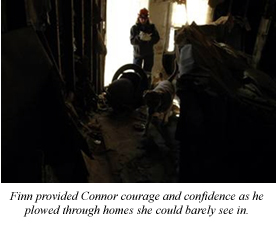 Every day in New Orleans held something different for Connor and her team. Some days they went over what other dogs had previously done to either confirm finds or confirm that nothing was found. Then when addresses of people reported missing started to come in, Connor and her team ventured to take a look at those sites. “What was interesting was trying to find addresses where there were no homes left at the site,” she said. “We started doing what we called signcutting for houses. In the wilderness, when we are trying to track a person we cut for sign, or signs that a person has passed through an area such as broken twigs, footprints, bent grass and trash. When we were signcutting for houses we learned to look for pushed over fences and damage to adjacent buildings that the house may have run into.”
Every day in New Orleans held something different for Connor and her team. Some days they went over what other dogs had previously done to either confirm finds or confirm that nothing was found. Then when addresses of people reported missing started to come in, Connor and her team ventured to take a look at those sites. “What was interesting was trying to find addresses where there were no homes left at the site,” she said. “We started doing what we called signcutting for houses. In the wilderness, when we are trying to track a person we cut for sign, or signs that a person has passed through an area such as broken twigs, footprints, bent grass and trash. When we were signcutting for houses we learned to look for pushed over fences and damage to adjacent buildings that the house may have run into.”
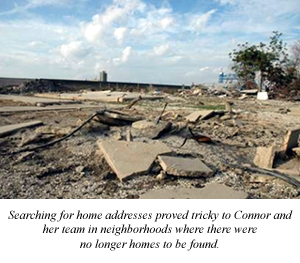 In terms of search and rescue mechanics, Connor explained that a dog’s search for remains is essentially the same as a search for live people. “Finn’s developed enough savvy to know when we are looking for live and when we are looking for deceased,” she said. “The situations are usually completely different and he’s learned that when there are a lot of people standing around and waiting and he is searching a small area, he knows we are looking for the dead.” To start him, Connor asks Finn ‘to go find’ and then he searches the specific area. “He usually keeps his nose to the ground to try and pinpoint the exact area where the scent is coming from,” she said. “However, a lot in the environment can disperse the scent. It is then up to me as a handler to read what Finn is telling me and interpret what is happening in the environment so that I can report where the scent is originating from.”
In terms of search and rescue mechanics, Connor explained that a dog’s search for remains is essentially the same as a search for live people. “Finn’s developed enough savvy to know when we are looking for live and when we are looking for deceased,” she said. “The situations are usually completely different and he’s learned that when there are a lot of people standing around and waiting and he is searching a small area, he knows we are looking for the dead.” To start him, Connor asks Finn ‘to go find’ and then he searches the specific area. “He usually keeps his nose to the ground to try and pinpoint the exact area where the scent is coming from,” she said. “However, a lot in the environment can disperse the scent. It is then up to me as a handler to read what Finn is telling me and interpret what is happening in the environment so that I can report where the scent is originating from.”
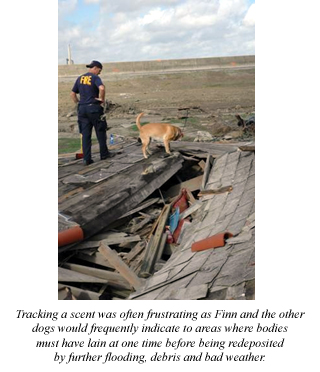 Connor noted that various factors affecting scent in New Orleans included mold, mud, open windows, holes in roofs, fallen ceilings and overturned furniture. “Even in the debris piles in the open, the scent can do tricky things,” she said. " Wind was significant (in New Orleans) and when it swirled around the piles it deposited scent everywhere. Scent sticks like glue to wet wood so even if there wasn’t a body there at the time the dogs were indicating, it means there had been a body there." Connor admitted that she felt like she was letting the firefighters down when Finn would indicate, emphatically, and they’d dig down to bare earth and there was nothing. One of the firefighters told Connor that he believed the dogs were indicating correctly and that bodies had in fact been there, but that not only had Katrina flooded the area but then Hurricane Rita came through and moved the bodies again. “Then there was still the mud and the mold we had to deal with,” Connor said. “Every day as I watched what Finn was doing I was better able to interpret what he was trying to tell me.”
Connor noted that various factors affecting scent in New Orleans included mold, mud, open windows, holes in roofs, fallen ceilings and overturned furniture. “Even in the debris piles in the open, the scent can do tricky things,” she said. " Wind was significant (in New Orleans) and when it swirled around the piles it deposited scent everywhere. Scent sticks like glue to wet wood so even if there wasn’t a body there at the time the dogs were indicating, it means there had been a body there." Connor admitted that she felt like she was letting the firefighters down when Finn would indicate, emphatically, and they’d dig down to bare earth and there was nothing. One of the firefighters told Connor that he believed the dogs were indicating correctly and that bodies had in fact been there, but that not only had Katrina flooded the area but then Hurricane Rita came through and moved the bodies again. “Then there was still the mud and the mold we had to deal with,” Connor said. “Every day as I watched what Finn was doing I was better able to interpret what he was trying to tell me.”
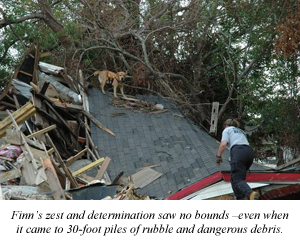 Connor noted that Finn is particularly suited for search and rescue work because he has a small build and is very agile and confident. “He’s able to think through problems as in where the scent is coming from in a difficult situation, he’s not fazed by strange things and he’s willing to work even in the toughest times and continue to work even when tired,” she said. She added that he is particularly skilled at problem solving. “If he can’t get over something, he’ll figure out how to go around,” Connor said. “When I let him out of the van in New Orleans, he took one look around and went ‘Yippee, yippee, let’s go and do this thing!’ and attacked it without looking back.” About Labs, Connor loves their zest for life and willingness to do anything that is asked of them.
Connor noted that Finn is particularly suited for search and rescue work because he has a small build and is very agile and confident. “He’s able to think through problems as in where the scent is coming from in a difficult situation, he’s not fazed by strange things and he’s willing to work even in the toughest times and continue to work even when tired,” she said. She added that he is particularly skilled at problem solving. “If he can’t get over something, he’ll figure out how to go around,” Connor said. “When I let him out of the van in New Orleans, he took one look around and went ‘Yippee, yippee, let’s go and do this thing!’ and attacked it without looking back.” About Labs, Connor loves their zest for life and willingness to do anything that is asked of them.
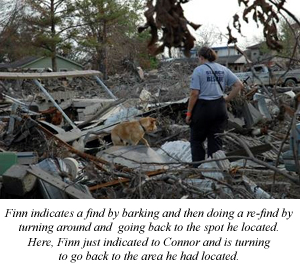 When not on call for search and rescue work, Connor is making housecalls for her veterinary practice. She specializes in small animals and also offers veterinary acupuncture among her services. In addition to Finn, Connor has a 16-year-old American yellow Lab that she rescued from her first job out of vet school and is also training a young female black Lab explicitly for cadaver work. In May, Connor lost her first search dog – a yellow Lab named Ben – to cancer. “Everything I’ve done, I owe to him,” she said.
When not on call for search and rescue work, Connor is making housecalls for her veterinary practice. She specializes in small animals and also offers veterinary acupuncture among her services. In addition to Finn, Connor has a 16-year-old American yellow Lab that she rescued from her first job out of vet school and is also training a young female black Lab explicitly for cadaver work. In May, Connor lost her first search dog – a yellow Lab named Ben – to cancer. “Everything I’ve done, I owe to him,” she said.
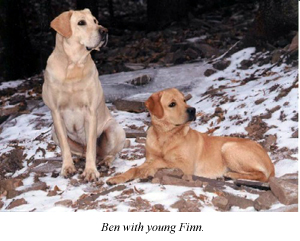 In truth, Ben is very much the reason Connor is involved in search and rescue work. Eight years ago, she saw a demonstration given by Blue and Gray SAR Dogs – the group she is currently with – and she joined them without a dog. She spent the first six months practicing and then started looking for her own dog when Ben literally wandered into her life. “He was a stray off the streets of Harrisonburg and he made me fall head over heels in love with the Labrador breed,” Connor said. “He was the kindest, gentlest, most patient, forgiving dog I have ever had the privilege of knowing. I made untold mistakes training him, but he waited for me to figure out how to fix my mistakes and then went on. Because of his tutelage I was able to learn how to train a search dog. Then when I got Finn, I was ahead of the curve and was able to train him to a higher level than Ben.” What keeps Connor invested in the work is “the thrill of watching my dog do what he is trained for. It astounds and amazes me every time we work.” Her greatest challenge is “trying to think of new ways to present problems to my dogs to keep them thinking and not reacting.”
In truth, Ben is very much the reason Connor is involved in search and rescue work. Eight years ago, she saw a demonstration given by Blue and Gray SAR Dogs – the group she is currently with – and she joined them without a dog. She spent the first six months practicing and then started looking for her own dog when Ben literally wandered into her life. “He was a stray off the streets of Harrisonburg and he made me fall head over heels in love with the Labrador breed,” Connor said. “He was the kindest, gentlest, most patient, forgiving dog I have ever had the privilege of knowing. I made untold mistakes training him, but he waited for me to figure out how to fix my mistakes and then went on. Because of his tutelage I was able to learn how to train a search dog. Then when I got Finn, I was ahead of the curve and was able to train him to a higher level than Ben.” What keeps Connor invested in the work is “the thrill of watching my dog do what he is trained for. It astounds and amazes me every time we work.” Her greatest challenge is “trying to think of new ways to present problems to my dogs to keep them thinking and not reacting.”
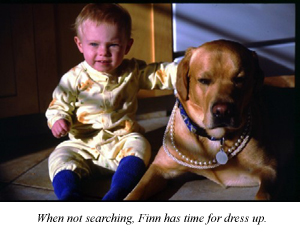 When not on the job being posed with new problems to figure out, Finn likes to take it easy by sleeping or going on hikes or trail rides with Connor. According to Connor his favorite food is “anything that tastes good,” although she does most of her training with him using low-fat chicken hot dogs. For his hard work and dedication as January’s Lab of the Month, let’s hope there’s plenty more of everything that tastes good in his future.
When not on the job being posed with new problems to figure out, Finn likes to take it easy by sleeping or going on hikes or trail rides with Connor. According to Connor his favorite food is “anything that tastes good,” although she does most of her training with him using low-fat chicken hot dogs. For his hard work and dedication as January’s Lab of the Month, let’s hope there’s plenty more of everything that tastes good in his future.
Click here to go back to Lab of the Month
By Regan Michelle White
 Although named for the mythical Irish warrior Finn who protected Ireland during the 4th and 5th centuries, handler Kathleen Connor jokes that “my Finn is more of a momma’s boy than a fearless warrior.” Connor implied that the appellation was perhaps more apt since Finn also means “fair-haired” and he is a yellow Lab. Despite his momma’s boy personality, the name may suit him better than his handler gives credit. Finn is a certified Search and Rescue dog. He does wilderness, water, cadaver, and recovery searches.
Although named for the mythical Irish warrior Finn who protected Ireland during the 4th and 5th centuries, handler Kathleen Connor jokes that “my Finn is more of a momma’s boy than a fearless warrior.” Connor implied that the appellation was perhaps more apt since Finn also means “fair-haired” and he is a yellow Lab. Despite his momma’s boy personality, the name may suit him better than his handler gives credit. Finn is a certified Search and Rescue dog. He does wilderness, water, cadaver, and recovery searches. In order to get certified, the team was required to complete a 40-acre day evaluation, a 40-acre night evaluation and a 160-acre day evaluation that tests the dog’s ability to continue searching efficiently for extended periods. “It also tests the handlers ability to implement a search strategy effectively, knowing at all times via map and compass where the team is in the search sector and to monitor their dog,” Connor said. “We are not allowed to miss any subjects that are located in that search sector and we only have six hours to do so.”
In order to get certified, the team was required to complete a 40-acre day evaluation, a 40-acre night evaluation and a 160-acre day evaluation that tests the dog’s ability to continue searching efficiently for extended periods. “It also tests the handlers ability to implement a search strategy effectively, knowing at all times via map and compass where the team is in the search sector and to monitor their dog,” Connor said. “We are not allowed to miss any subjects that are located in that search sector and we only have six hours to do so.”Due to the very nature of search and rescue work, the frequency of Connor and Finn’s deployment from their home near Harrisonburg, VA is sporadic. Some months they are called out every week and other times they can witness a three-month spell without a single call. Connor estimates that she and Finn average around 20 callouts a year. Typical searches the pair are called out for include drownings, house fires, lost hikers, lost children, Alzheimer’s patients, lost hunters, suicides and the hijinks of young men with too much to drink.
The dog team must be recertified every two years, thus training, training and more training is paramount to an effective team. Many times this training requires travel to other states. Finn has trained from Michigan to Mississippi, from Utah to Pennsylvania. Connor tries to attend at least one seminar a year. This past year, she attended one that worked on ‘Cadaster’ dog training, or training a cadaver dog in a disaster situation. “As luck would have it, I completed the seminar about two weeks before I was deployed to New Orleans,” she said. “They called it cadaster, but there is no training in the world that could prepare a dog team for what it was like in New Orleans.”
 A team of two dog handlers – including Connor – and four support staff left for New Orleans on November 13 and returned November 21. It took the team 18 hours over the course of two days to drive there. “It was not really a search and rescue mission, it was described as a recovery mission,” Connor said. “We were in the 9th Ward, right next to the levee that broke. We searched about a thirty block area.” Every morning the team would arrive at the staging area located at a former elementary school. The team would then receive their assignment for the day, round up the fire and police force members that were to accompany them for the day and then head out to the assigned sector. “We needed the police for protection,” Connor said. “We were more at risk from the feral dogs than people. Although, by the time we left more and more people were entering the area illegally, some to loot – for what, I don’t know, because there was nothing left – and others to gawk.”
A team of two dog handlers – including Connor – and four support staff left for New Orleans on November 13 and returned November 21. It took the team 18 hours over the course of two days to drive there. “It was not really a search and rescue mission, it was described as a recovery mission,” Connor said. “We were in the 9th Ward, right next to the levee that broke. We searched about a thirty block area.” Every morning the team would arrive at the staging area located at a former elementary school. The team would then receive their assignment for the day, round up the fire and police force members that were to accompany them for the day and then head out to the assigned sector. “We needed the police for protection,” Connor said. “We were more at risk from the feral dogs than people. Although, by the time we left more and more people were entering the area illegally, some to loot – for what, I don’t know, because there was nothing left – and others to gawk.”  Members of the fire department came along to aid in breaking down doors and moving heavy obstacles. Connor and her team would quit for lunch around noon when they would head back to base to decontaminate by washing the dogs in a diluted solution of Clorox and Dawn dishwashing detergent and then rinsing them with a diluted chlorhexidine (antibacterial) solution. “In the afternoon we’d head out for another couple of hours of searching, come back, go through decon (decontamination) and head back to the hotel,” Connor said. “After dinner, the group would get together to discuss what happened that day and what we could do the next day to improve. Then (we’d) collapse into bed.”
Members of the fire department came along to aid in breaking down doors and moving heavy obstacles. Connor and her team would quit for lunch around noon when they would head back to base to decontaminate by washing the dogs in a diluted solution of Clorox and Dawn dishwashing detergent and then rinsing them with a diluted chlorhexidine (antibacterial) solution. “In the afternoon we’d head out for another couple of hours of searching, come back, go through decon (decontamination) and head back to the hotel,” Connor said. “After dinner, the group would get together to discuss what happened that day and what we could do the next day to improve. Then (we’d) collapse into bed.”  In terms of the task at hand, Connor explained that it wasn’t the work itself but the magnitude of its scale that was stupefying. “The actual work was not bad, just overwhelming,” she said. Connor described how during their first morning in the 9th Ward, everyone went for a tour of the area to be able to familiarize themselves with the devastation and the magnitude of what had occurred. “It took us several hours until we could get our minds wrapped around the situation and actually work,” she said. “I was petrified that Finn was going to hurt himself and was almost afraid to let him work. But when I let him out of the van he attacked every situation, every rubble pile, every destroyed home with complete confidence. I knew that I was going to be the weak link in the team and that if I didn’t get myself together I would take us out of the equation quickly. I gained my confidence from Finn. He never blinked or shirked at anything I asked him to do, whether it be a destroyed home where I couldn’t see a darn thing in the rooms he went through or climbing to the top of a 30-foot rubble pile chasing a scent.” When asked to attempt to compare it to other situations she and Finn have braved together, Connor’s reply was swift and decisive, “There is no comparison.”
In terms of the task at hand, Connor explained that it wasn’t the work itself but the magnitude of its scale that was stupefying. “The actual work was not bad, just overwhelming,” she said. Connor described how during their first morning in the 9th Ward, everyone went for a tour of the area to be able to familiarize themselves with the devastation and the magnitude of what had occurred. “It took us several hours until we could get our minds wrapped around the situation and actually work,” she said. “I was petrified that Finn was going to hurt himself and was almost afraid to let him work. But when I let him out of the van he attacked every situation, every rubble pile, every destroyed home with complete confidence. I knew that I was going to be the weak link in the team and that if I didn’t get myself together I would take us out of the equation quickly. I gained my confidence from Finn. He never blinked or shirked at anything I asked him to do, whether it be a destroyed home where I couldn’t see a darn thing in the rooms he went through or climbing to the top of a 30-foot rubble pile chasing a scent.” When asked to attempt to compare it to other situations she and Finn have braved together, Connor’s reply was swift and decisive, “There is no comparison.”  Every day in New Orleans held something different for Connor and her team. Some days they went over what other dogs had previously done to either confirm finds or confirm that nothing was found. Then when addresses of people reported missing started to come in, Connor and her team ventured to take a look at those sites. “What was interesting was trying to find addresses where there were no homes left at the site,” she said. “We started doing what we called signcutting for houses. In the wilderness, when we are trying to track a person we cut for sign, or signs that a person has passed through an area such as broken twigs, footprints, bent grass and trash. When we were signcutting for houses we learned to look for pushed over fences and damage to adjacent buildings that the house may have run into.”
Every day in New Orleans held something different for Connor and her team. Some days they went over what other dogs had previously done to either confirm finds or confirm that nothing was found. Then when addresses of people reported missing started to come in, Connor and her team ventured to take a look at those sites. “What was interesting was trying to find addresses where there were no homes left at the site,” she said. “We started doing what we called signcutting for houses. In the wilderness, when we are trying to track a person we cut for sign, or signs that a person has passed through an area such as broken twigs, footprints, bent grass and trash. When we were signcutting for houses we learned to look for pushed over fences and damage to adjacent buildings that the house may have run into.” In terms of search and rescue mechanics, Connor explained that a dog’s search for remains is essentially the same as a search for live people. “Finn’s developed enough savvy to know when we are looking for live and when we are looking for deceased,” she said. “The situations are usually completely different and he’s learned that when there are a lot of people standing around and waiting and he is searching a small area, he knows we are looking for the dead.” To start him, Connor asks Finn ‘to go find’ and then he searches the specific area. “He usually keeps his nose to the ground to try and pinpoint the exact area where the scent is coming from,” she said. “However, a lot in the environment can disperse the scent. It is then up to me as a handler to read what Finn is telling me and interpret what is happening in the environment so that I can report where the scent is originating from.”
In terms of search and rescue mechanics, Connor explained that a dog’s search for remains is essentially the same as a search for live people. “Finn’s developed enough savvy to know when we are looking for live and when we are looking for deceased,” she said. “The situations are usually completely different and he’s learned that when there are a lot of people standing around and waiting and he is searching a small area, he knows we are looking for the dead.” To start him, Connor asks Finn ‘to go find’ and then he searches the specific area. “He usually keeps his nose to the ground to try and pinpoint the exact area where the scent is coming from,” she said. “However, a lot in the environment can disperse the scent. It is then up to me as a handler to read what Finn is telling me and interpret what is happening in the environment so that I can report where the scent is originating from.”  Connor noted that various factors affecting scent in New Orleans included mold, mud, open windows, holes in roofs, fallen ceilings and overturned furniture. “Even in the debris piles in the open, the scent can do tricky things,” she said. " Wind was significant (in New Orleans) and when it swirled around the piles it deposited scent everywhere. Scent sticks like glue to wet wood so even if there wasn’t a body there at the time the dogs were indicating, it means there had been a body there." Connor admitted that she felt like she was letting the firefighters down when Finn would indicate, emphatically, and they’d dig down to bare earth and there was nothing. One of the firefighters told Connor that he believed the dogs were indicating correctly and that bodies had in fact been there, but that not only had Katrina flooded the area but then Hurricane Rita came through and moved the bodies again. “Then there was still the mud and the mold we had to deal with,” Connor said. “Every day as I watched what Finn was doing I was better able to interpret what he was trying to tell me.”
Connor noted that various factors affecting scent in New Orleans included mold, mud, open windows, holes in roofs, fallen ceilings and overturned furniture. “Even in the debris piles in the open, the scent can do tricky things,” she said. " Wind was significant (in New Orleans) and when it swirled around the piles it deposited scent everywhere. Scent sticks like glue to wet wood so even if there wasn’t a body there at the time the dogs were indicating, it means there had been a body there." Connor admitted that she felt like she was letting the firefighters down when Finn would indicate, emphatically, and they’d dig down to bare earth and there was nothing. One of the firefighters told Connor that he believed the dogs were indicating correctly and that bodies had in fact been there, but that not only had Katrina flooded the area but then Hurricane Rita came through and moved the bodies again. “Then there was still the mud and the mold we had to deal with,” Connor said. “Every day as I watched what Finn was doing I was better able to interpret what he was trying to tell me.” Connor noted that Finn is particularly suited for search and rescue work because he has a small build and is very agile and confident. “He’s able to think through problems as in where the scent is coming from in a difficult situation, he’s not fazed by strange things and he’s willing to work even in the toughest times and continue to work even when tired,” she said. She added that he is particularly skilled at problem solving. “If he can’t get over something, he’ll figure out how to go around,” Connor said. “When I let him out of the van in New Orleans, he took one look around and went ‘Yippee, yippee, let’s go and do this thing!’ and attacked it without looking back.” About Labs, Connor loves their zest for life and willingness to do anything that is asked of them.
Connor noted that Finn is particularly suited for search and rescue work because he has a small build and is very agile and confident. “He’s able to think through problems as in where the scent is coming from in a difficult situation, he’s not fazed by strange things and he’s willing to work even in the toughest times and continue to work even when tired,” she said. She added that he is particularly skilled at problem solving. “If he can’t get over something, he’ll figure out how to go around,” Connor said. “When I let him out of the van in New Orleans, he took one look around and went ‘Yippee, yippee, let’s go and do this thing!’ and attacked it without looking back.” About Labs, Connor loves their zest for life and willingness to do anything that is asked of them. When not on call for search and rescue work, Connor is making housecalls for her veterinary practice. She specializes in small animals and also offers veterinary acupuncture among her services. In addition to Finn, Connor has a 16-year-old American yellow Lab that she rescued from her first job out of vet school and is also training a young female black Lab explicitly for cadaver work. In May, Connor lost her first search dog – a yellow Lab named Ben – to cancer. “Everything I’ve done, I owe to him,” she said.
When not on call for search and rescue work, Connor is making housecalls for her veterinary practice. She specializes in small animals and also offers veterinary acupuncture among her services. In addition to Finn, Connor has a 16-year-old American yellow Lab that she rescued from her first job out of vet school and is also training a young female black Lab explicitly for cadaver work. In May, Connor lost her first search dog – a yellow Lab named Ben – to cancer. “Everything I’ve done, I owe to him,” she said.  In truth, Ben is very much the reason Connor is involved in search and rescue work. Eight years ago, she saw a demonstration given by Blue and Gray SAR Dogs – the group she is currently with – and she joined them without a dog. She spent the first six months practicing and then started looking for her own dog when Ben literally wandered into her life. “He was a stray off the streets of Harrisonburg and he made me fall head over heels in love with the Labrador breed,” Connor said. “He was the kindest, gentlest, most patient, forgiving dog I have ever had the privilege of knowing. I made untold mistakes training him, but he waited for me to figure out how to fix my mistakes and then went on. Because of his tutelage I was able to learn how to train a search dog. Then when I got Finn, I was ahead of the curve and was able to train him to a higher level than Ben.” What keeps Connor invested in the work is “the thrill of watching my dog do what he is trained for. It astounds and amazes me every time we work.” Her greatest challenge is “trying to think of new ways to present problems to my dogs to keep them thinking and not reacting.”
In truth, Ben is very much the reason Connor is involved in search and rescue work. Eight years ago, she saw a demonstration given by Blue and Gray SAR Dogs – the group she is currently with – and she joined them without a dog. She spent the first six months practicing and then started looking for her own dog when Ben literally wandered into her life. “He was a stray off the streets of Harrisonburg and he made me fall head over heels in love with the Labrador breed,” Connor said. “He was the kindest, gentlest, most patient, forgiving dog I have ever had the privilege of knowing. I made untold mistakes training him, but he waited for me to figure out how to fix my mistakes and then went on. Because of his tutelage I was able to learn how to train a search dog. Then when I got Finn, I was ahead of the curve and was able to train him to a higher level than Ben.” What keeps Connor invested in the work is “the thrill of watching my dog do what he is trained for. It astounds and amazes me every time we work.” Her greatest challenge is “trying to think of new ways to present problems to my dogs to keep them thinking and not reacting.” When not on the job being posed with new problems to figure out, Finn likes to take it easy by sleeping or going on hikes or trail rides with Connor. According to Connor his favorite food is “anything that tastes good,” although she does most of her training with him using low-fat chicken hot dogs. For his hard work and dedication as January’s Lab of the Month, let’s hope there’s plenty more of everything that tastes good in his future.
When not on the job being posed with new problems to figure out, Finn likes to take it easy by sleeping or going on hikes or trail rides with Connor. According to Connor his favorite food is “anything that tastes good,” although she does most of her training with him using low-fat chicken hot dogs. For his hard work and dedication as January’s Lab of the Month, let’s hope there’s plenty more of everything that tastes good in his future.Click here to go back to Lab of the Month
Featured Article
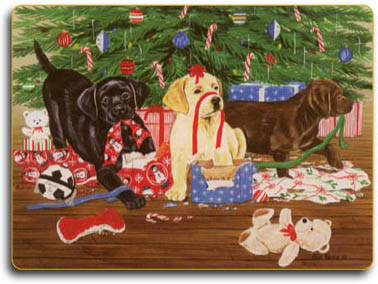 Can You Spot The Holiday Hazards?
Can You Spot The Holiday Hazards?
It’s easy for pets, especially Labradors, to get into trouble during the holidays. You may get so busy that you lose track of what is going on with your dog.
Click here to learn more about: "Can You Spot The Holiday Hazards?"
 Can You Spot The Holiday Hazards?
Can You Spot The Holiday Hazards?It’s easy for pets, especially Labradors, to get into trouble during the holidays. You may get so busy that you lose track of what is going on with your dog.
Click here to learn more about: "Can You Spot The Holiday Hazards?"
Wanted: Models

Would you like to see your Lab pictured here? Send us images of your Lab and we may include them on our Home Page!

Would you like to see your Lab pictured here? Send us images of your Lab and we may include them on our Home Page!
Labrador Library
Labrador Links
The Verstaile Lab
History of the Lab
Advice
Travel
Featured Labs
Featured Artists
Labrador Links
The Verstaile Lab
History of the Lab
Advice
Travel
Featured Labs
Featured Artists
.jpg)

